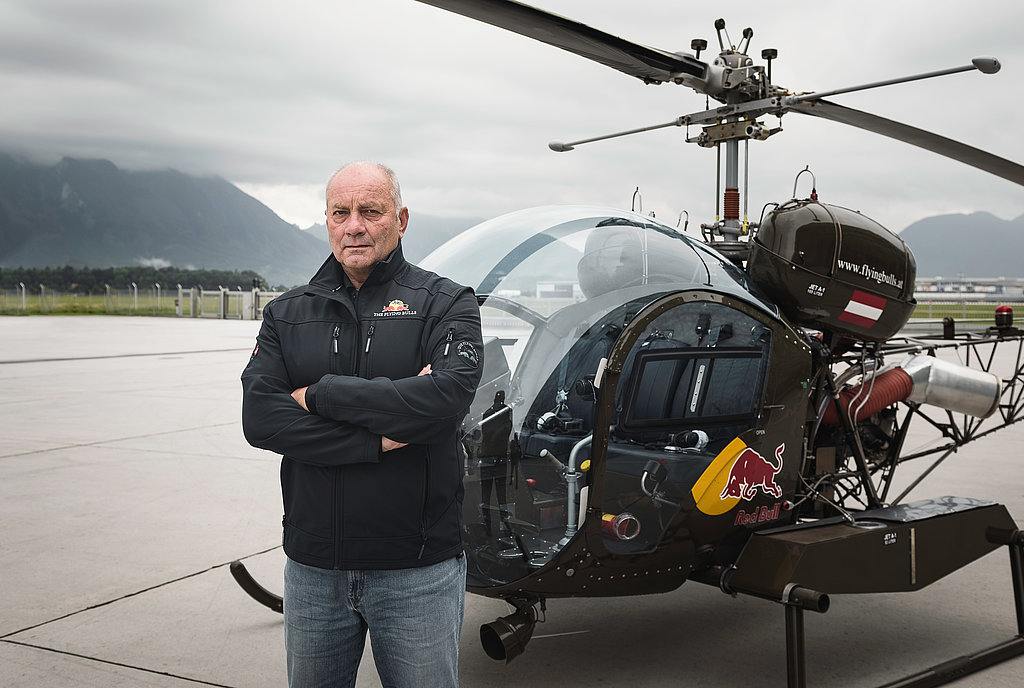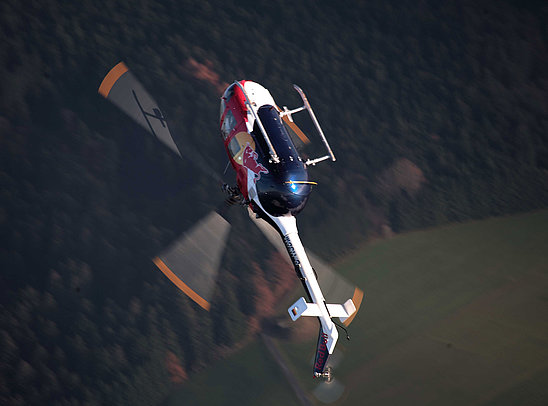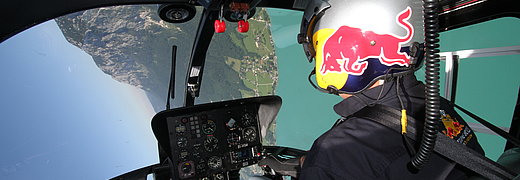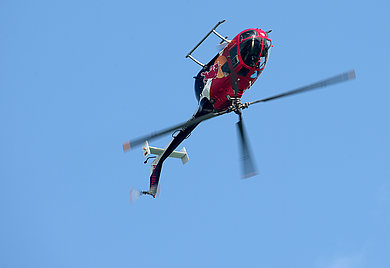ANNIVERSARY OF A HELICOPTER LEGEND
“Sitting in a helicopter that only you can fly is an incredible feeling”
From an aeronautical perspective, Siegfried “Blacky” Schwarz has experienced almost all there is to experience. After starting his career as a helicopter pilot in the aerial photography trade, he conducted transport and rescue flights for Heli-Air, before spending more than 20 years as an emergency pilot at the ÖAMTC. Today’s chief helicopter pilot of The Flying Bulls is a twice-over Helicopter Freestyle World Champion and the only Austrian with a civilian helicopter aerobatics license. This October, our aviation legend with no less than 12,000 flying hours celebrates his 60th birthday. We believe that warrants an interview…
1. DID YOU, IN YOUR MIND, CHOOSE THE PROFESSION OF YOUR DREAMS?
SSCH: Absolutely. It is certainly a unique job that cannot be compared to any other profession in the world. As a child, plastic plane models were my passion. Basically, I had models of what one can see here in Hangar-7. It’s almost inconceivable when I look at the aircrafts in Hangar-7, especially when I had such a dream as a child.
2. CAN YOU EVEN IMAGINE A FUTURE WITHOUT FLYING?
SSCH: Yes, because I have reached a certain age. I started flying back in 1977, so it’s been a while. I do have enough interests besides aviation. But flying is, of course, a big part of my life.
3. HOW DID YOU GET INTO THE FLYING BUSINESS?
SSCH: I was an aircraft mechanic for the SAAB 105 in the army. At that time, the military offered the option to commit oneself for a certain amount of time in exchange for using part of said time for training. A colleague and I were sitting together one day and came up with the idea of obtaining a pilot’s licence. In my early 20s, I was one of the first civilian helicopter trainees in Austria. Before that, there wasn’t even a flying school of sorts.
4. AND WHAT HAPPENED NEXT?
SSCH: It all fizzled out, really. My license expired, because nobody knew how the business worked. After my training, I worked as a taxi driver. I used my savings to travel to America, where I repeated the pilot license training. That’s when my career really started. It was a difficult time in America, especially as there was no Internet yet and there were very few sources of information. In addition, I hardly spoke any English. It was tough, but it all went well. When I returned to Austria, the aerial photography industry was experiencing a veritable boom. So I started off taking aerial photographs before I joined Heli-Air in Innsbruck, where I flew transport and rescue mission in a helicopter. In addition, I took out a million Schilling loan from a bank and launched a flying school in Graz.
5. DID YOU EVER CONSIDER A DIFFERENT PROFESSION?
SSCH: No, never. Once you have been in this job for so long, you kind of forget what “normal” work is. Everyone who has ever had such a job will confirm that it is very difficult to return to working eight hours a day. I was at the air rescue unit of ÖAMTC for 21 years. I was on duty for seven days and then had seven days off. One gets used to that.
6. WHICH MOMENTS ARE THE MOST MEMORABLE? WHAT WERE YOUR GREATEST CHALLENGES?
SSCH: I remember transport missions that involved placing power pylons on bolts. Seeing that such a pylon is very heavy, the fuel I could take on only lasted for five minutes. The four bolts wouldn’t fit. I was hovering up there. The aircraft was at its limit and the fuel lamp was flashing. (laughs) Naturally, I remember many rescue flights. For example, we had to pull someone out of a glacier crevasse and rescue people from mountain faces at night. And then there are special highlights, of course. When we were at the Air Race in Japan, we flew to the summit of Mount Fuji. Who else gets to do that?
7. YOU’RE NOT THE ONLY ONE CELEBRATING A 60TH BIRTHDAY THIS YEAR. THE SAME APPLIES TO THE BRISTOL 171 SYCAMORE. HOW DO YOU FEEL ABOUT THAT PARTICULAR AIRCRAFT?
SSCH: My greatest concern was always the fact that the rotor blades are made of wood. 60 years old and glued together - that requires an enormous amount of faith. We had the two oldest rotor blades examined at the University of Technology in Graz. It turned out that they were in perfect condition. I felt a little more at ease after that!
8. HOW WAS YOUR FIRST FLIGHT IN THE SYCAMORE?
SSCH: It was an incredible challenge. I was aware that taking off would be tricky; one needs to pull the controls to the right. But nobody had told me how far and when I should pull the controls back again. During the first lift-off, the tail skid hit the ground. That must have looked quite unruly at first glance. (laughs) But sitting in a helicopter of which only one of its kind exists worldwide - and that only you can fly - is an incredible feeling.
9. WHAT CHARACTERISTICS DOES THE SYCAMORE HAVE FROM A PILOT’S POINT OF VIEW?
SSCH: The trimming wheels are certainly an unusual feature. Depending on flight condition and speed, one needs to trim the controls, because it would require an enormous effort without hydraulics. That’s why one has the trimming wheels. They need to be turned constantly to ensure that they pull the stick in the right direction. It’s quite cumbersome, really.
10. WHAT ARE THE CHALLENGES WHEN FLYING THE SYCAMORE?
SSCH: Man hat viel Arbeit, da die Steuerung mechanisch erfolgt. Das ist nicht so wie bei einem modernen Hubschrauber, wo alles ein Computer regelt. Man muss ständig auf die Rotor- und Motordrehzahl, die Geschwindigkeit, den Ladedruck und Anstellwinkel schauen. Das ist wie bei einem Oldtimer.
11. LET’S TALK ABOUT THE FUTURE: WHAT ARE YOUR WISHES?
SSCH: One of my dreams is that The Flying Bulls manage to obtain a Sikorsky S-58. It’s a great helicopter that is ideal for sightseeing flights. At some point, I would also like to see a successor for the Eurocopter EC135. But my biggest dream is that the Cobra flies again one day.



